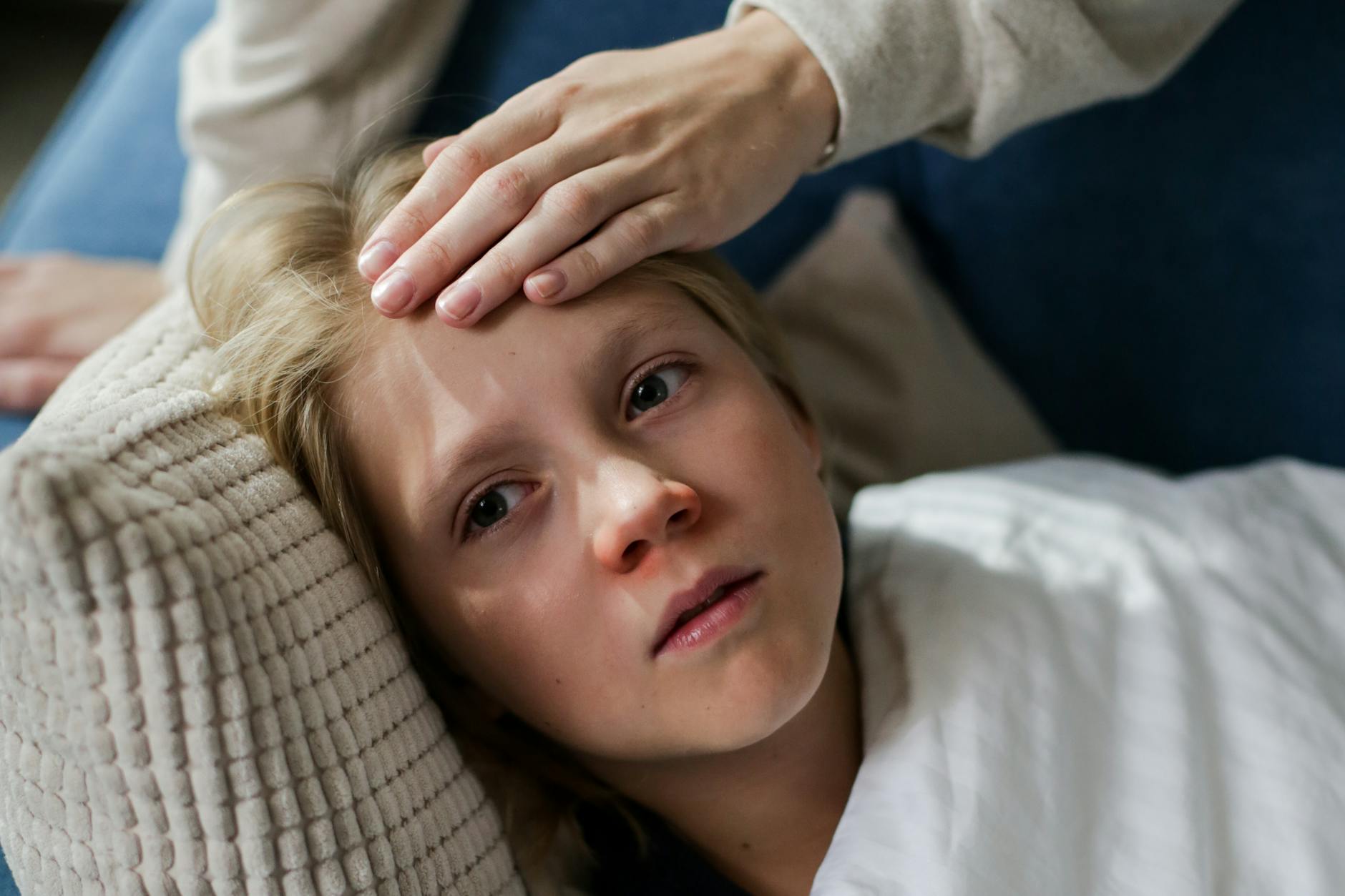3 Common Childhood Ailments Every Parent Should Know would be on every parent’s resume. These sicknesses come faster than a speeding locomotive. It can sometimes feel like childhood comes with a rolling contract for the sniffles and temperature.
The thing we usually need to look closer at is if it’s just a passing bug or something that needs more attention.
Understanding the most common childhood ailments can save a doctor’s visit or even a few sleepless nights on the trot.
The Dreaded Twins.. Cold and Flu
We’ve seen, heard and dealt with the cold and flu numerous times over. It comes with a runny nose, cough and a line of tissue around the house. These symptoms are a wreck for any parent’s plans or routines.
For the most part, children recover fairly quickly with some attentive care at home. However, knowing what to look for and how to tackle the symptoms correctly, so they don’t spread or worsen, can be the tricky part.
Also, the dreaded, when to get help from your doctor when it gets too hairy.
Knowing the Symptoms of Cold and Flu in Children
 Photo by Vika Glitter
Photo by Vika Glitter
With both cold and flu, the first sign is an unusual sign of tiredness and fussiness in children. There can be a few symptoms that overlap, but there are a few differences worth knowing.
Typical cold symptoms:
- Runny or stuffy nose
- Mild sore throat
- Cough or sneezing
- Low-grade fever (sometimes no)
- Watery eyes
Flu symptoms may be a bit slightly severe:
- Higher fever, sometimes sudden
- Chills or body aches
- Headache
- Sore throat
- Tiredness or weakness
Sometimes children will not be able to pinpoint or say exactly how they feel clearly. Try to keep an eye out if your child becomes more clingy, loses their appetite and has a hard time sleeping.
See trusted guides for Cold and Flu and symptoms for both.
Home and Over-the-Counter Remedies That Work
Most times, when the little ones get sick, the go-to solutions are to get them as comfortable as possible at home. We (parents) usually focus on letting them get rest, hydration and symptom relief. This is how sick days are treated with us:
- Keep fluids flowing: Offer water, clear broth, or warm, chicken soup, caffeine-free teas to soothe a sore throat and prevent dehydration.
- Make them rest: Allow them to nap as much as they want. Rest allows the body to recover faster.
- Use a cool-mist humidifier: Moist air can ease stuffy noses and help your child breathe more comfortably.
- Saline nasal sprays: These help with the mucus in the nose, especially for the younger ones who cannot blow their nose.
- Fever relief: Acetaminophen or ibuprofen helps lower fever and reduce aches.
There is no need for complex solutions, the simple comforting solutions work just as good. For the younger children, make sure to double-check with your pediatrician before giving any over-the-counter medications, mainly cough and cold syrups.
When Cold & Flu Symptoms Cross the Line
While most time we don’t even associate a cold or flu with a doctor’s visit, at times they are needed. When the symptoms get increasingly more serious, trust your gut and make the call.
These are your ‘don’t ignore it’ signs — call your doctor if:
- Problem breathing or rapid breathing
- Chest pain or a non-stop cough
- A fever that lasts more than three days or is higher than 104°F (40°C)
- Gradual ear pain, severe headache, or persistent vomiting
- Signs of dehydration, like dry mouth, no tears, or not urinating
- Extreme tiredness or difficulty waking your child
For infants, to prevent and keep an eye for potential complications like ear infections or pneumonia, contact your physician.
For more information about contacting your Dr. and symptoms, click here CLICK.
Ear Infections 101: Causes, Symptoms & When to Worry
Ear infections are another pretty common, troublesome occurrence in children that can turn the most cheerful child miserable, faster than you can say 1, 2, 3. (My father’s saying.)
The last thing any parent wants is to see their child in pain, rubbing their ear restlessly, unable to fall asleep for discomfort.
With ear infection, you need to know why they develop and how to treat them.
What Really Causes Ear Infections in Children

Photo by Towfiqu Barbhuiya
Ear infections occur in children more often than in adults because the tubes connecting their ears to the back of the throat (called Eustachian tubes) are shorter and more horizontal.
This means that germs have an easier access to travel from the nose and throat into the ear, especially during or after a cold.
Common causes and risk factors include:
- A recent cold or upper respiratory infection causes swelling and buildup of fluid.
- Allergies can block or restrict drainage and trap fluid.
- Pacifier use and secondhand smoke can increase the risk.
- Daycare attendance causes a higher introduction to germs.
The majority of children with ear infections are caused in the middle ear. Fluid builds up behind the eardrum, creating the perfect temperature for the virus to grow.
Usual rapid signs are:
- Ear pain (tends to be worse when lying down)
- Hearing difficulty
- Fever
- Tugging or pulling at the ear
- Trouble sleeping and being fussy
- Fluid draining from the ear (in severe cases)
An ear infection, when not treated properly, can sometimes result in complications, including hearing loss and in rare circumstances more serious infections.
Hence the importance of keeping a close eye on symptoms, especially after a cold or when your child seems off for more than day or two.
Home Treatments for Ear Infections
The first priority for an ear infection is finding relief. In a mild case, it’s often supported at home, but it’s good to know when a call to the doctor is the next step.
Simple steps to ease discomfort:
- Give acetaminophen or ibuprofen (based on your doctor’s advice).
- Give warm compresses on the sore ear.
- Keeping your child upright will relieve the pressure.
- Keep hydrated.
Most infections caused by viruses clear up by themselves, usually after a few days. In other cases, antibiotics are needed if bacterial infection is the cause and doesn’t improve.
With this, your pediatrician with do the necessary tests (ear) and decide the appropriate treatment. The American Academy of Pediatrics not every infection needs antibiotics, which prevents medicine resistance.
Signs that mean a doctor should check your child:
- Severe pain, high fever, or symptoms lasting for more than two days
- Ear discharge
- Hearing loss or trouble balancing
- Signs of dehydration or that your child is very unwell
Some children with frequent ear infections may need to see an ear, nose and throat specialist (ENT) for further care or to discuss if tubes might need help.
Preventing Recurring Ear Infections in Kids
There are some kids who are prone to ear infections and steps should be taken to lower the odds of it happening again. Here are a few practical ways to lower the chances of an ear infections:
- Encourage hand washing: Good hygiene helps to prevent the spread of germs.
- Limit pacifier use after the age of 6 months.
- Keep your child away from secondhand smoke. Smoke irritates the Eustachian tubes.
- Breastfeeding infants helps to boost the immune system.
- Stay current with recommended vaccines, including the flu shot and pneumococcal vaccine, which can lessen the odds of infection.
- Help your child avoid contact with sick children as much as possible, and even more during cold and flu season.
If your child is at risk or experiences multiple cases of ear infection, it might be time to speak to a specialist about ways to reduce the risk of future episodes.
The Scoop on Stomach Bugs: Gastroenteritis
Gastroenteritis, the scientific name for stomach bugs, is among the most common ailments in our kids. These messy sicknesses can come out of nowhere and sweep through entire classrooms and families.
Kids’ immune systems at this point in their lives are very vulnerable, due to still learning to fight off new germs. Being able to combat these situations and being aware of the benefits of hydration and nutrition will definitely give your family a better chance to fight off these miserable stomach bugs.
Knowing Gastroenteritis in Children
This sick feeling usually pops up like an uninvited guest at Thanksgiving. One moment your child is chippy, the next, not so much and looking for the nearest bathroom. Stomach bugs are caused by viruses (commonly norovirus and rotavirus), bacteria, or even parasites that spread very easily through shared surfaces, contaminated food and water.
 Photo by cottonbro studio
Photo by cottonbro studio
Common symptoms are:
- Diarrhea (frequent watery stool)
- Vomiting
- Belly cramps and pain
- Mild fever or cold chills
- Loss of appetite
- Tiredness and irritability
These symptoms create the worst-case scenario for hydration, so actions must be taken immediately when these signs appear.
Managing Dehydration and Nutrition During Illness
The biggest concern about stomach bugs is the dehydration associated with them. Kids tend to quickly lose fluids through diarrhea and vomiting. There are also a few other signs to look out for, such as dry mouth, fewer wet diapers, dark urine, no tears when crying, or listlessness.
Best tactics to help your child stay hydrated and nourished:
- Offer small sips of water, clear broths, or pediatric electrolyte solutions
- Continue breastfeeding or formula for infants as tolerated
- Avoid fruit juices and sugary drinks, which can worsen diarrhea
- Gradually reintroduce bland foods like bananas, rice, applesauce, and toast once vomiting slows
For what it’s worth, it is good to know that stomach bugs go away on their own after a couple of days. The best source of action is to keep the child comfortable and push fluids as tolerated. Pausing solid food is not necessary for too long- let your child eat when they are hungry.
How To Prevent Short and Long-Term
The first things are good hygiene and smart choices at home and in group settings. Since these bugs are so contagious, the little things make a big difference
Try these steps:
- Thoroughly wash hands (especially after using the bathroom and before eating)
- Disinfect surfaces in bathrooms and kitchens often
- Teach kids not to share drinks, utensils, or towels during illness
- Keep sick kids home from school or daycare until symptom-free for at least 24 hours
Using these steps long-term to prevent gastroenteritis, like getting the rotavirus vaccine, for example, helps to prevent stomach bugs in toddlers and babies.
When you know what to watch for and how to respond, you can help have the upper hand for prevention, faster recovery and even prevention of further infections
Although I am a parent living away from my family, there are routines that we put in place to track new symptoms and follow a clear plan for prevention, including hydration and timely doctor visits. Keeping up with vaccinations and focusing on a holistic way of eating is vital to a stronger immune system.
If you ever notice unusual changes in your child’s appetite or growth, be vigilant and follow proper procedures.
I love and appreciate connecting with others who care deeply about children’s health like I do. Thank you for reading and making your child’s health a priority.
Feel free to share your own tips or questions—the more we learn together, the better we can respond to the ups and downs of childhood illnesses.




3 Comments
Comments are closed.